AMD's Richland vs. Intel's Haswell GPU on the Desktop: Radeon HD 8670D vs. Intel HD 4600
by Anand Lal Shimpi on June 6, 2013 12:00 PM ESTMetro: Last Light
Metro: Last Light is the latest entry in the Metro series of post-apocalyptic shooters by developer 4A Games. Like its processor, Last Light is a game that sets a high bar for visual quality, and at its highest settings an equally high bar for system requirements thanks to its advanced lighting system. This doesn’t preclude it from running on iGPUs thanks to the fact that it scales down rather well, but it does mean that we have to run at fairly low resolutions to get a playable framerate.
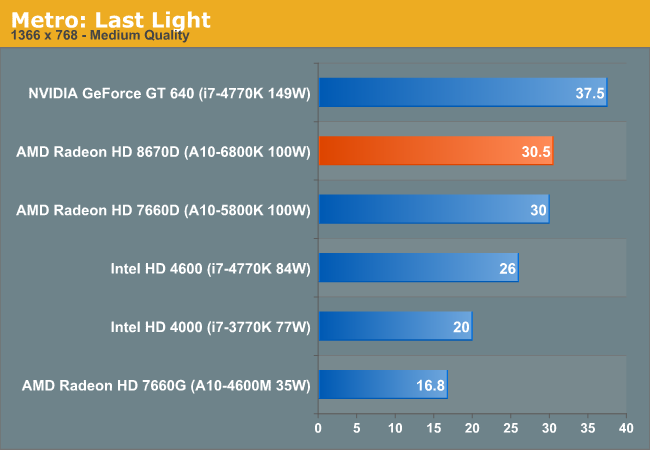
Looking at desktop parts alone, Intel really suffers from not having a socketed GT3 SKU. Although HD 4600 is appreciably faster than HD 4000 (+30%), both Trinity and Richland are around 17% faster than it. As you'll see, Metro ends up being one of the smaller gaps between the two in our suite.
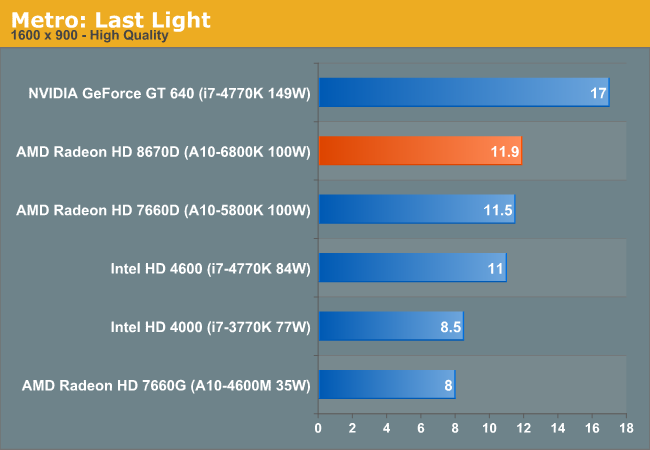
As memory bandwidth becomes the ultimate bounding condition, the gap between Richland and Haswell shrinks considerably. Note that on the HD 4600 side, the difference between DDR3-1333 and DDR3-2400 is only 10% here. Given the limited performance of the 20 EU Haswell GPU configuration, it doesn't seem like Intel is all that bandwidth limited here.
BioShock: Infinite
Bioshock Infinite is Irrational Games’ latest entry in the Bioshock franchise. Though it’s based on Unreal Engine 3 – making it our obligatory UE3 game – Irrational had added a number of effects that make the game rather GPU-intensive on its highest settings. As an added bonus it includes a built-in benchmark composed of several scenes, a rarity for UE3 engine games, so we can easily get a good representation of what Bioshock’s performance is like.
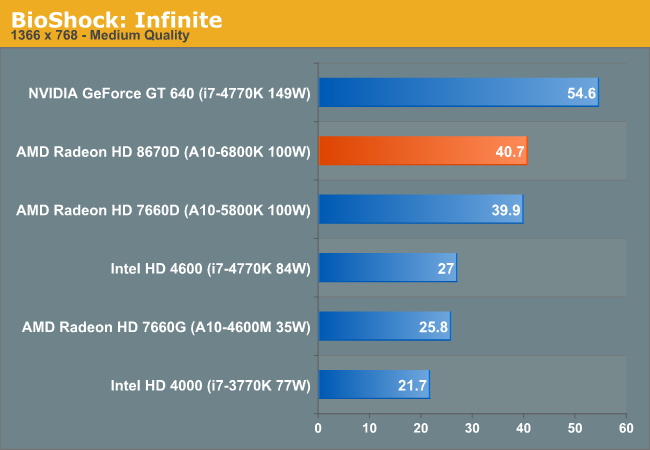
If Metro was an example of the worst case scenario for Richland, BioShock: Infinite is the best case scenario. Here the Radeon HD 8670D holds a 50% performance advantage over Intel's HD 4600 graphics.
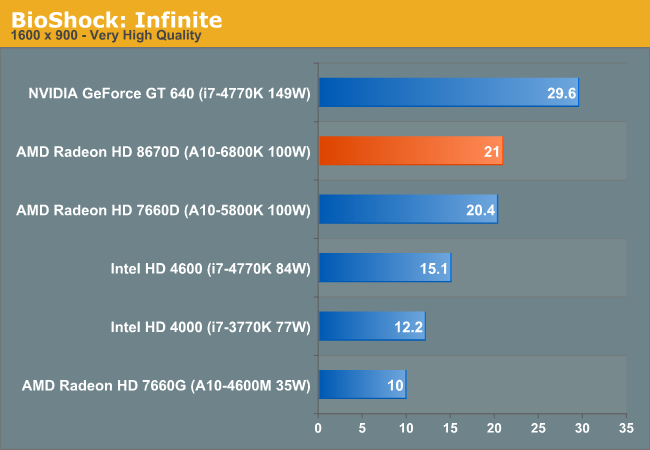
The gap narrows a bit at higher resolution/quality settings, but it's still 39%.
Sleeping Dogs
A Square Enix game, Sleeping Dogs is one of the few open world games to be released with any kind of benchmark, giving us a unique opportunity to benchmark an open world game. Like most console ports, Sleeping Dogs’ base assets are not extremely demanding, but it makes up for it with its interesting anti-aliasing implementation, a mix of FXAA and SSAA that at its highest settings does an impeccable job of removing jaggies. However by effectively rendering the game world multiple times over, it can also require a very powerful video card to drive these high AA modes.
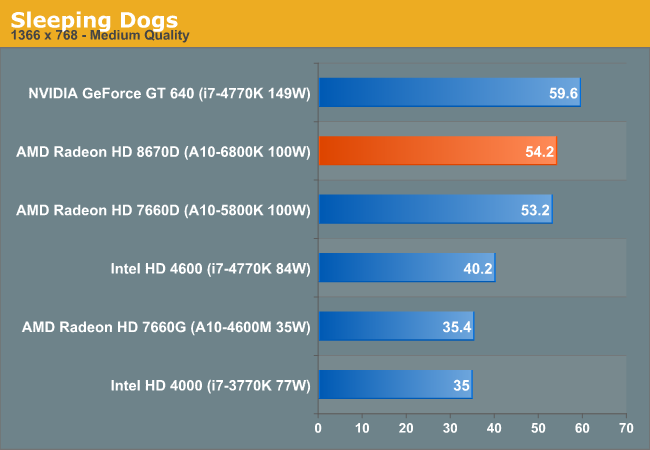
Richland is approaching 60 fps in our Sleeping Dogs benchmark at medium quality, definitely not bad at all. The advantage over Intel's HD 4600 is 34%.
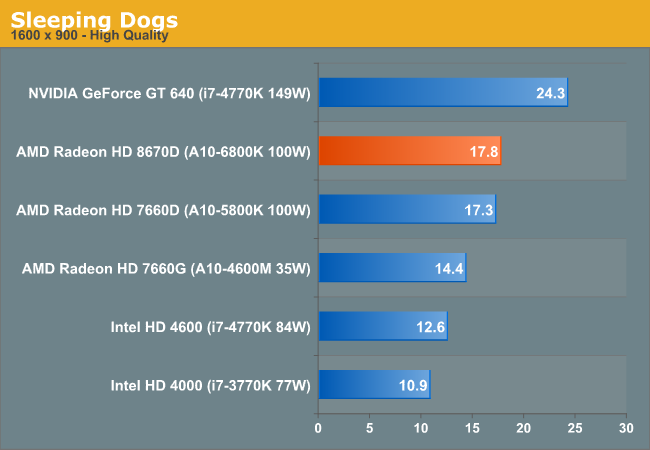
The performance advantage grows a bit at the higher quality/resolution settings, however we drop below the line of playability. With most of these games, you can trade off image quality for resolution however.
Tomb Raider (2013)
The simply titled Tomb Raider is the latest entry in the Tomb Raider franchise, making a clean break from past titles in plot, gameplay, and technology. Tomb Raider games have traditionally been technical marvels and the 2013 iteration is no different. iGPUs aren’t going to have quite enough power to use its marquee feature – DirectCompute accelerated hair physics (TressFX) – however even without it the game still looks quite good at its lower settings, while providing a challenge for our iGPUs.

Tomb Raider is another title that doesn't put Richland in the best light, but it still ends up around 23% faster than Haswell GT2.
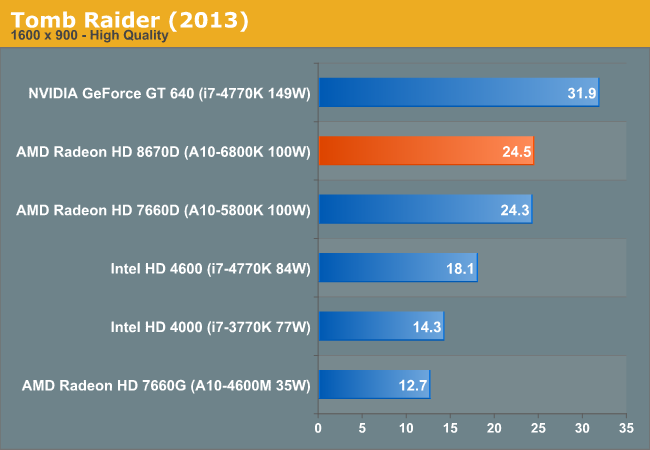
Battlefield 3
Our multiplayer action game benchmark of choice is Battlefield 3, DICE’s 2011 multiplayer military shooter. Its ability to pose a significant challenge to GPUs has been dulled some by time and drivers at the high-end, but it’s still a challenge for more entry-level GPUs such as the iGPUs found on Intel and AMD's latest parts. Our goal here is to crack 60fps in our benchmark, as our rule of thumb based on experience is that multiplayer framerates in intense firefights will bottom out at roughly half our benchmark average, so hitting medium-high framerates here is not necessarily high enough.
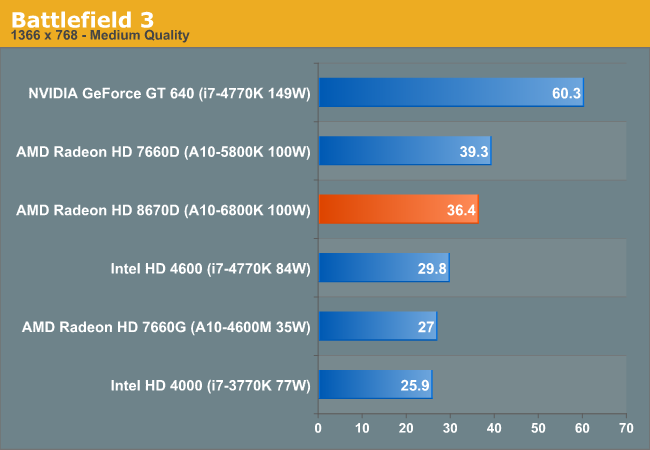
Richland's performance in Battlefield 3 climbs around 30% over the HD 4600 regardless of quality/resolution.

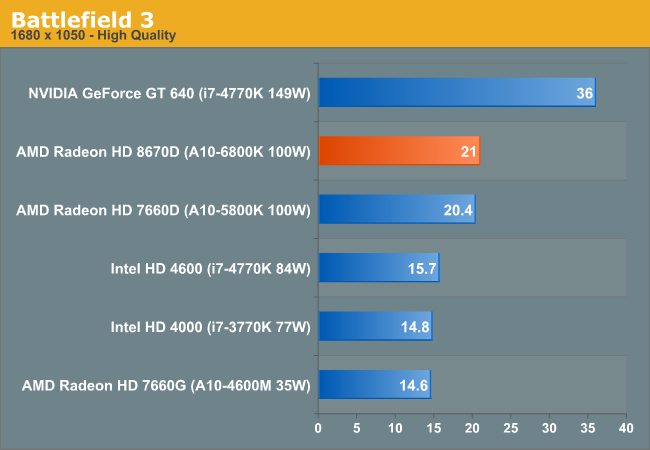
Crysis 3
With Crysis 3, Crytek has gone back to trying to kill computers, taking back the “most punishing game” title in our benchmark suite. Only in a handful of setups can we even run Crysis 3 at its highest (Very High) settings, and the situation isn't too much better for entry-level GPUs at its lowest quality setting. In any case Crysis 1 was an excellent template for the kind of performance required to drive games for the next few years, and Crysis 3 looks to be much the same for 2013.

Crysis is another benchmark where we see an increase in performance in the low 30% range.
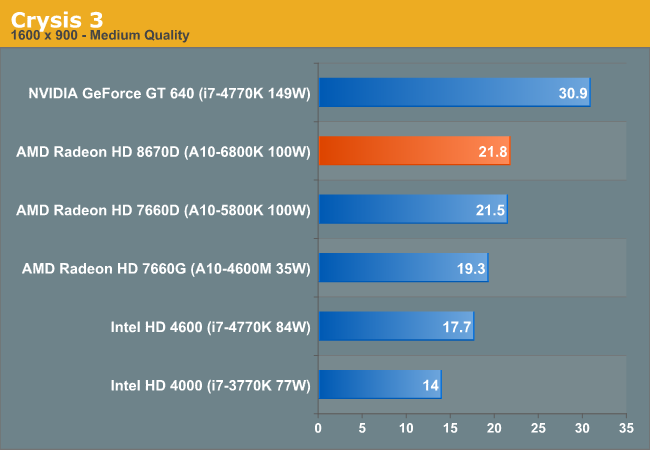











102 Comments
View All Comments
mrSmigs - Friday, June 7, 2013 - link
It still amazes me that websites bench the i7s vs the amd a10 platforms. Whole a10 systems can be purchased for the price of an i7 CPU. Why dont you test a $200 graphics card in an a10 system vs the i7 integrated graphics - if this is the case and show people what they can get (for their $350 dollars spent on cpu + graphics)???? The closest price processor from intel vs 6800k that i found locally was an i3 3240. Why dont you use these in the comparisons?????? Why use a Gt640 only with an i7 & not on the amd system to show the cpu bias in the benches???DeviousOrange - Friday, June 7, 2013 - link
While yes the i7 being the fastest mainline part available and x86 will help distort its numbers a bit nevertheless the issue is not x86, the issue is iGPU performance only. That being said the i7 4770K and A10 6800K are both the top line parts in review so there is no ambiguity as to one being entry level and the other top line, these are both flagships so the test is top product on top product iGPU showdown.What is disappointing is Anandtech still don't have any workable Frame Scaling tool to asses performance as Frames Per Second means diddly squat where Frame Latency is the true indicator. As before the A10 is always below 10ms and often below 1ms while the i7's HD4600 often hits 60ms+ latencies which is basically a microstut.tut.tut.tut.tut.ter.
I haven't personally tested HD4600 but I have been told it has boosted FPS but in terms of frame transistions which are often a combination of hardware and driver support that HD4600 is not much better so again while HD4600 is close in FPS in some instance, its very far off in latency. In short I would rather have a iGPU average 27FPS but have 0.1ms latencies opposed to 35FPS with 50ms latencies.
mrSmigs - Friday, June 7, 2013 - link
The comparison is amd's budget apu line vs intels top desktop line. You should throw a radeon 7850 in the amd system to even up the specs (at least dollars wise) and then run a few graphics benches... please someone do a comparison i7-4770k with its iGPU vs a10-6800k+7850hd in gaming. im pretty sure i could guess the winner here...sireangelus - Friday, June 7, 2013 - link
Just think about the performance of a i74770KR... 128 mb of L4 cache, an amount to put to shame any serverPhiro69 - Friday, June 7, 2013 - link
" AMD is proud of its valiation on the A10-6800K" - you mean validation, right?halbhh2 - Friday, June 7, 2013 - link
While it is interesting to see gaming benches, since I might game on an HTPC, I'm actually thinking more on how perfectly the chips can display a 4K video, *and* I'm interested in whether I can run 2 HD movies (two at once) on 2 displays without any dropped frames or stutters (this actually matters a bit at the moment for me). I know there is one article here for the Intel 4600 graphics re 4K.hobagman - Saturday, June 8, 2013 - link
Anand, I think this is a waste of time. I don't know anybody who buys desktops anymore, unless they intend to use it as a workstation or as a gaming platform. In the first case, they don't usually care about graphics, and in the second case, they will absolutely have discrete graphics and these graphics benchmarks are utterly irrelevant. I like this website and appreciate the work, but I would rather you spend your time on something more useful for us -- for example, comparing the notebook platform integrated graphics would be reasonable. This article puzzles me.fteoath64 - Saturday, June 8, 2013 - link
"comparing the notebook platform integrated graphics would be reasonable.". There are many reviews about IGP for the APUs for specific users or gamers. This article highlights how much AMD has arrived in terms of gpu and cpu balance in their desktop and notebook parts (ie APUs specifically) which will pose a serious challenge to Intel's dominance. To many, Intel based cpu with IGP is clearly not the way to go only Intel cpu plus Nvidia discrete gpu or go the APU route and compromise cpu somewhat gaining close to discretely gpu performance for way less money.Also shows that Intel 4600 IGP has gone a long way to within striking distance of AMD APU gpus but not good enough as the sliding scale of reference MOVES each time Intel approaches. The GT3e potentially can match a NV 650M discrete but at the cost of Intel $$$ to the user. Most manufacturers rather go Nvidia discrete which is cheaper and better as well. So unless Intel goes into heterogeneous core architecture chips for cpus, there is nothing really new in their offering.
zyky - Saturday, June 8, 2013 - link
With the dozens of different configurations that call themselves "GT 640" It's pretty important to specify which one was used in these tests. GF116? GK107? GK208? GDDR3? GDDR5?Ryan Smith - Tuesday, June 18, 2013 - link
There's only one retail GT 640 (as of this article); the GK107 based DDR3 version.